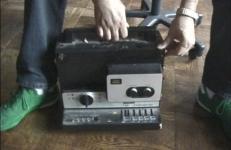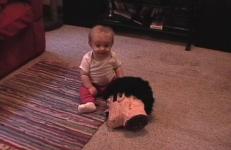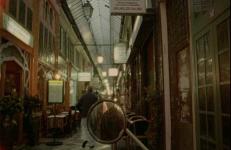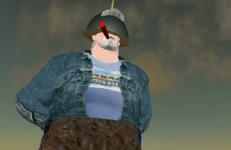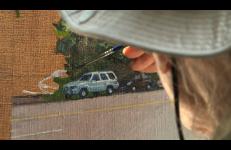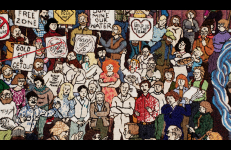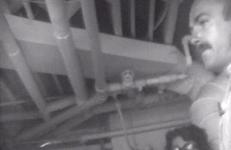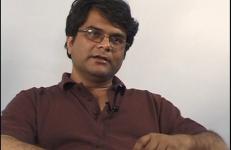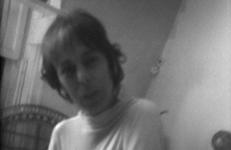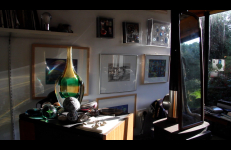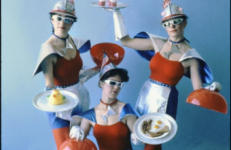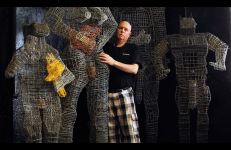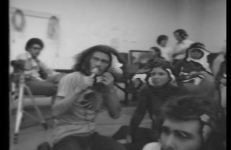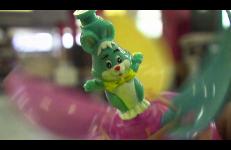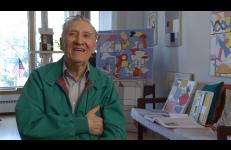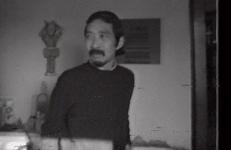This piece purports to be about the discontinuation of the much-loved format, Kodachrome, and with it the further endangerment of super-8 film. But it has other agendas of reclamation and personal reckoning that are its true subject matter.
Artist Spaces
In 1998 I made a sculpture of a decapitated head. I featured it in a photo and video. I thought of the head as a character whose adventures would be documented. The name O’Malley was inspired by Chicago’s Irish heritage (I was living in Chicago then). O’Malley’s Head Part 1 was a photo of the head placed on top of the garbage cans in the alley behind my apartment building. I lived right by an exit ramp from the Kennedy Expressway, one of the last before you reached downtown from O’Hare Airport. Sometimes people would exit there and dump things.
Open Conch is a spell for pleasure and queer desire.
Open Conch takes fragments from portraits of lesbians and queer identified women from Bonn in spaces they requested to be recorded in. Choices include houseboat homes, kitchens, dining room tables, bridges, tunnels, graffiti and other public spaces. A main character with pink hair follows the conch to find what is actually natural; such as circles of women dreaming, the slaying of the patriarchy by a red wooden sword and the calling in of queer love through movement, fabric, sound and circle.
Open Conch is a spell for pleasure and queer desire.
Open Conch takes fragments from portraits of lesbians and queer identified women from Bonn in spaces they requested to be recorded in. Choices include houseboat homes, kitchens, dining room tables, bridges, tunnels, graffiti and other public spaces. A main character with pink hair follows the conch to find what is actually natural; such as circles of women dreaming, the slaying of the patriarchy by a red wooden sword and the calling in of queer love through movement, fabric, sound and circle.
An homage to Walter Benjamin and other time-traveling artists and expatriates that have inspired me, especially Chris Marker. Benjamin, fleeing from fascism in the 1930s, took refuge in Paris where Biblioteque Nacional became his home away from home.
An ex-student of mine opens up in the privacy of her home and shows me her etchings (watercolors) as we talk of art and things that slip under the fabric of daily attire. - George Kuchar
If second lives have grown into the landscape of social network space and avatars engage a full range of human emotions and experience, it follows that they would eventually encounter existential questions. A plot of land is purchased in the online network of SecondLife and a simple questions is asked: Where do discarded 3D objects go and can we build a dumpster to accommodate them? To find out eteam set aside a year to let this virtual land use problem unfold and what is captured in Prim Limit is the lived experience of avatars managing and recording this dumpster.
Since the early 1970s, Rackstraw Downes has committed himself to painting from observation, on site, from start to finish. He has painted both urban and rural landscapes, as well as interior spaces, in New York, Texas, and Maine. Although he paints exactly what he sees, through his labor ordinary sites become transformed into extraordinary scenes.
In the face of environmental threats, a radical back-to-the-land community in the Sierra Foothills races to collectively stitch its 50 years of innovative sustainability into an epic 83-foot tapestry, one tiny stitch at a time. San Juan Ridge, an alternative collective of artists and ecologists in the Sierra Foothills, saved the Yuba River from being dammed while surviving numerous challenges like mining, logging, and climate change-created drought and wildfires. Bay Area media artist Jeanne C.
A look at the town of Rome N.Y., including an arts panel visit to the Art and Community Center.
In this interview, Indian artist Shuddhabrata Sengupta (b. 1968) discusses his role in the initiation of the Raqs Media Collective, a Delhi-based artist collective, active since the 1990s. At the time of this interview, Raqs had been creating documentaries, art installations, and educational programs for eighteen years. Sengupta likens the driving force of Raqs to that of a game of catch, a process generated by a back-and-forth dialogue mobilized through writing and in-person meetings. As children of the late sixties, Sengupta explains how and why the members of Raqs, (himself, Jeebesh Bagchi and Monica Narula) share an interest in investigating mass communication, technologies of visibility, and the significance of memory and travel. It is also for this reason, Sengjupta explains, that the Collective’s work is committed to fostering rigorous research in addition to art-making endeavors.
Parry Teasdale, David Cort and Chuck Kennedy visit The Kitchen in New York looking for Shirley Clarke, and bump into Steina and Woody Vasulka who are overseeing a show in progress. A few doors down they find Shirley in her studio, dressed in white and full of energy.
The Spender House in Essex was designed in 1968 by Richard and Su Rogers (Team 4) for photographer and artist Humphrey Spender. The film is a biographical portrait of both architecture and inhabitant.
Spender died in 2005 but his spirit is still very present in the house and studio. The film explores the unique architectural qualities of the house and studio and provides a glimpse of its former inhabitant’s life and work as a painter, textile designer and photographer of British life in the 1930s for Mass Observation.
“Nobody likes you if they think you’re rude- you better act the way you should.” But we didn’t.
Telling it the way it was lived, Susan Mogul’s short film captures the energy, passion and radical spirit of the Los Angeles Woman’s Building (1973-1991), a groundbreaking center for women’s culture.
That Which Is Possible is a portrait of a community of painters, sculptors, musicians and writers making work at the Living Museum, an art-space on the grounds of a large state-run psychiatric facility in Queens, New York. Shot over the course of two years and structured across the arc of a day, the film observes with an intimate lens and unspools like a musical, both bracing and tender. That Which Is Possible explores the liberatory and reparative functions that creative action has for a group of artists drawn together by shared struggle.
The video content—a live-feed image processing tape—shows intellectual discussion among SAIC Video Area students and faculty members. Instead of being a prescriptive monologue from school to students, Phil sits among the crowd and moderates the session. The decentralized and non-hierarchical academic setting—students and faculty sitting on the floor and cushions in a circle—is typical of the ’70s. At times, students burst into laughter, dancing, and lounging on the floor, hence creating a laid-back environment.
The latest in Marie Losier's ongoing series of film portraits of avant-garde directors (George and Mike Kuchar, Guy Maddin, Richard Foreman), DreaMinimalist offers an insightful and hilarious encounter with Conrad as he sings, dances and remembers his youth and his association with Jack Smith.
Too Many Things visits the world of objects — their accumulation and dispersal — and their creation of cummunities of curiosity. The title is somewhat ironic. My work has always fed on things as the symbolic and incidental expressions of human presence. For a photographer, or a filmmaker, there can never be too many things; the camera likes to ferret them out and hang onto them, just as some people do. "Piled-up structures of inference and implication," as Clifford Geertz described ethnography's places of study, have also been my sites of activity as an arti
tryphon: three sounds is a candid portrait of the artist Thomas H. Kapsalis (b.
As a well-known painter and collagist, teacher at the School of the Art Institute of Chicago and mentor to the Chicago Imagists, Ray Yoshida (1930-2009) had far reaching influence. In this interview, Yoshida offers a tour of his home, showing us the unique dolls, masks, trinkets and tattoo art from which he drew inspiration. Describing his own stylistic progression from the late 1950s to the early 1970s, Yoshida also talks about the collage aesthetic and persistence of visual complication in the Chicago Imagist style, demonstrating its various permutations by showing off his collection of works by former students at SAIC. A lover of curiosities, Yoshida also describes discussions he had with Chicago artist Roger Brown about opening a museum for their vast collections of oddities.
— Kyle Riley




